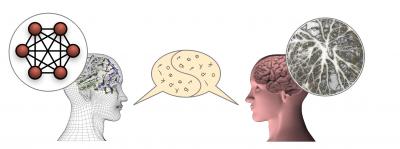| Online: | |
| Visits: | |
| Stories: |

| Story Views | |
| Now: | |
| Last Hour: | |
| Last 24 Hours: | |
| Total: | |
A Network of Artificial Neurons Learns To Use Human Language
A group of researchers from the University of Sassari (Italy) and the University of Plymouth (UK) has developed a cognitive model, made up of two million interconnected artificial neurons, able to learn to communicate using human language starting from a state of “tabula rasa”, only through communication with a human interlocutor.
Credit: Bruno Golosio
We might think that the brain works in a similar way to a computer: after all, even computers work through electrical signals. In fact, many researchers have proposed models based on the analogy brain-is-like-a-computer since the late ’60s. However, apart from the structural differences, there are profound differences between the brain and a computer, especially in learning and information processing mechanisms. Computers work through programs developed by human programmers. In these programs there are coded rules that the computer must follow in handling the information to perform a given task. However there is no evidence of the existence of such programs in our brain. In fact, today many researchers believed that our brain is able to develop higher cognitive skills simply by interacting with the environment, starting from very little innate knowledge. The ANNABELL model appears to confirm this perspective.
ANNABELL does not have pre-coded language knowledge; it learns only through communication with a human interlocutor, thanks to two fundamental mechanisms, which are also present in the biological brain: synaptic plasticity and neural gating. Synaptic plasticity is the ability of the connection between two neurons to increase its efficiency when the two neurons are often active simultaneously, or nearly simultaneously. This mechanism is essential for learning and for long-term memory. Neural gating mechanisms are based on the properties of certain neurons (called bistable neurons) to behave as switches that can be turned “on” or “off” by a control signal coming from other neurons. When turned on, the bistable neurons transmit the signal from a part of the brain to another, otherwise they block it. The model is able to learn, due to synaptic plasticity, to control the signals that open and close the neural gates, so as to control the flow of information among different areas.
The cognitive model has been validated using a database of about 1500 input sentences, based on literature on early language development, and has responded by producing a total of about 500 sentences in output, containing nouns, verbs, adjectives, pronouns, and other word classes, demonstrating the ability to express a wide range of capabilities in human language processing.
Contacts and sources:
University of Sassari
Citation: Golosio B, Cangelosi A, Gamotina O, Masala GL (2015) A Cognitive Neural Architecture Able to Learn and Communicate through Natural Language. PLoS ONE 10(11): e0140866. doi:10.1371/journal.pone.0140866 http://dx.plos.org/10.1371/journal.pone.0140866
Source: http://www.ineffableisland.com/2015/11/a-network-of-artificial-neurons-learns.html




